Smart Buildings and IoT: Strategies for Implementation in Construction
VerifiedAdded on 2022/12/29
|29
|7173
|43
Report
AI Summary
This report investigates the implementation of smart buildings based on the Internet of Things (IoT), examining the challenges of traditional buildings and the advantages of smart technologies. It explores the concept of IoT and its applications in the construction industry, focusing on energy efficiency, safety, and employee productivity. The research methodology includes a qualitative approach, using secondary data from journals, articles, and books. The findings analyze the impact of IoT on smart buildings and provide strategies for enhancing implementation. The report concludes with recommendations for future research and development, emphasizing the potential of IoT to transform the construction industry and create more sustainable and efficient buildings. The study highlights the importance of smart sensors, automation, and data analysis in optimizing building performance and enhancing the living and working environments.
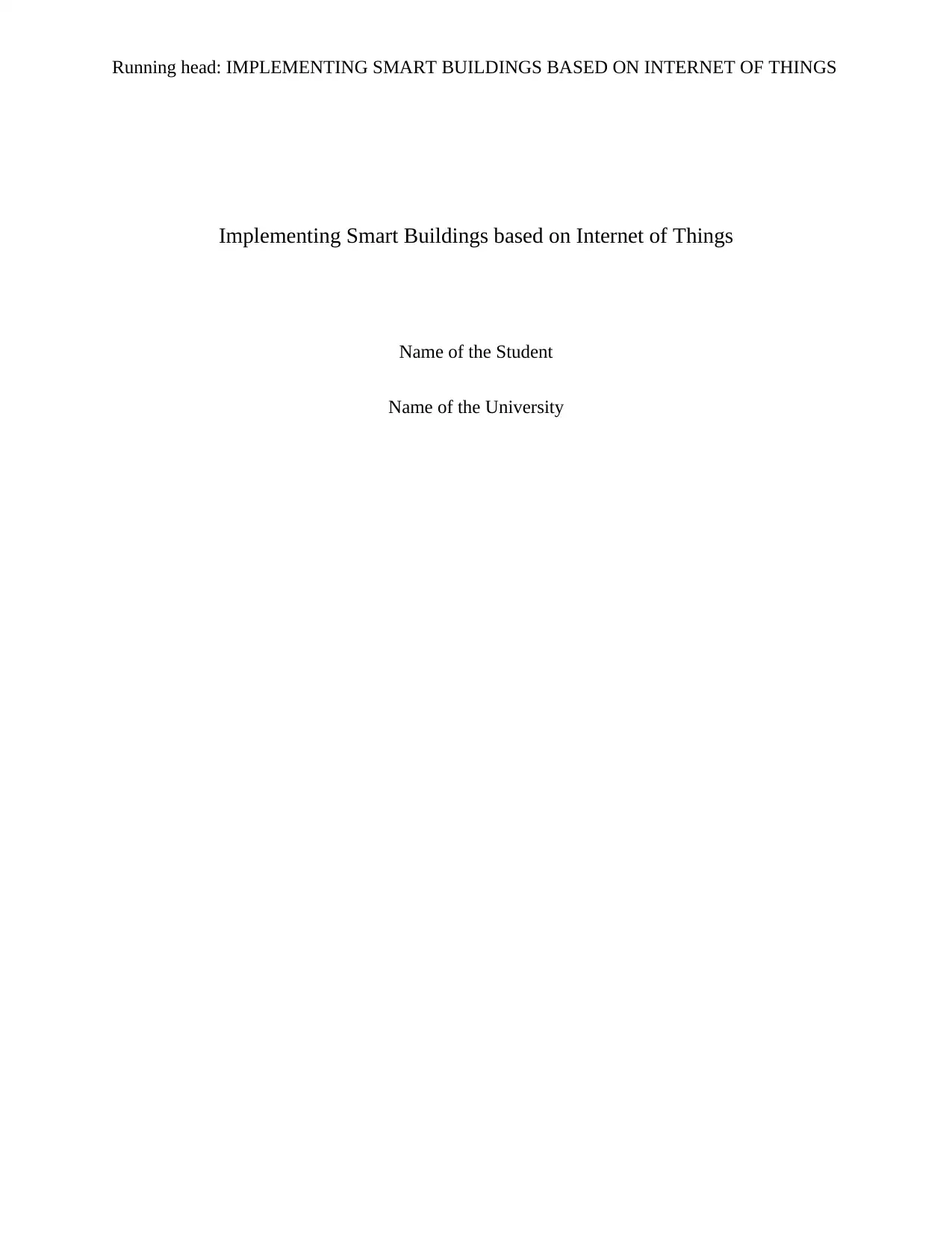
Running head: IMPLEMENTING SMART BUILDINGS BASED ON INTERNET OF THINGS
Implementing Smart Buildings based on Internet of Things
Name of the Student
Name of the University
Implementing Smart Buildings based on Internet of Things
Name of the Student
Name of the University
Paraphrase This Document
Need a fresh take? Get an instant paraphrase of this document with our AI Paraphraser
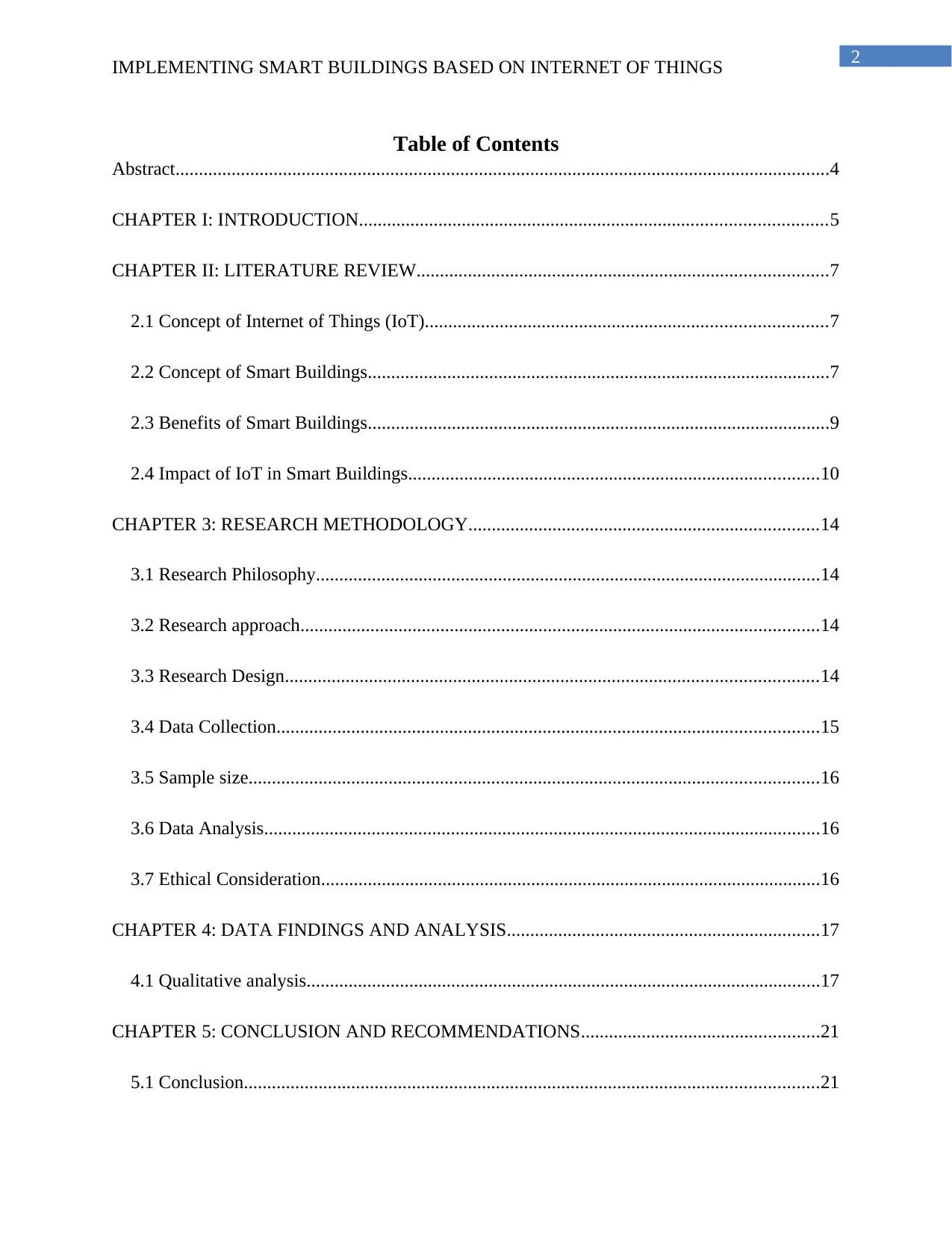
2
IMPLEMENTING SMART BUILDINGS BASED ON INTERNET OF THINGS
Table of Contents
Abstract............................................................................................................................................4
CHAPTER I: INTRODUCTION....................................................................................................5
CHAPTER II: LITERATURE REVIEW........................................................................................7
2.1 Concept of Internet of Things (IoT)......................................................................................7
2.2 Concept of Smart Buildings...................................................................................................7
2.3 Benefits of Smart Buildings...................................................................................................9
2.4 Impact of IoT in Smart Buildings........................................................................................10
CHAPTER 3: RESEARCH METHODOLOGY...........................................................................14
3.1 Research Philosophy............................................................................................................14
3.2 Research approach...............................................................................................................14
3.3 Research Design..................................................................................................................14
3.4 Data Collection....................................................................................................................15
3.5 Sample size..........................................................................................................................16
3.6 Data Analysis.......................................................................................................................16
3.7 Ethical Consideration...........................................................................................................16
CHAPTER 4: DATA FINDINGS AND ANALYSIS...................................................................17
4.1 Qualitative analysis..............................................................................................................17
CHAPTER 5: CONCLUSION AND RECOMMENDATIONS...................................................21
5.1 Conclusion...........................................................................................................................21
IMPLEMENTING SMART BUILDINGS BASED ON INTERNET OF THINGS
Table of Contents
Abstract............................................................................................................................................4
CHAPTER I: INTRODUCTION....................................................................................................5
CHAPTER II: LITERATURE REVIEW........................................................................................7
2.1 Concept of Internet of Things (IoT)......................................................................................7
2.2 Concept of Smart Buildings...................................................................................................7
2.3 Benefits of Smart Buildings...................................................................................................9
2.4 Impact of IoT in Smart Buildings........................................................................................10
CHAPTER 3: RESEARCH METHODOLOGY...........................................................................14
3.1 Research Philosophy............................................................................................................14
3.2 Research approach...............................................................................................................14
3.3 Research Design..................................................................................................................14
3.4 Data Collection....................................................................................................................15
3.5 Sample size..........................................................................................................................16
3.6 Data Analysis.......................................................................................................................16
3.7 Ethical Consideration...........................................................................................................16
CHAPTER 4: DATA FINDINGS AND ANALYSIS...................................................................17
4.1 Qualitative analysis..............................................................................................................17
CHAPTER 5: CONCLUSION AND RECOMMENDATIONS...................................................21
5.1 Conclusion...........................................................................................................................21

3
IMPLEMENTING SMART BUILDINGS BASED ON INTERNET OF THINGS
5.2 Recommendations................................................................................................................21
5.3 Research Plan.......................................................................................................................22
References......................................................................................................................................24
IMPLEMENTING SMART BUILDINGS BASED ON INTERNET OF THINGS
5.2 Recommendations................................................................................................................21
5.3 Research Plan.......................................................................................................................22
References......................................................................................................................................24
⊘ This is a preview!⊘
Do you want full access?
Subscribe today to unlock all pages.

Trusted by 1+ million students worldwide
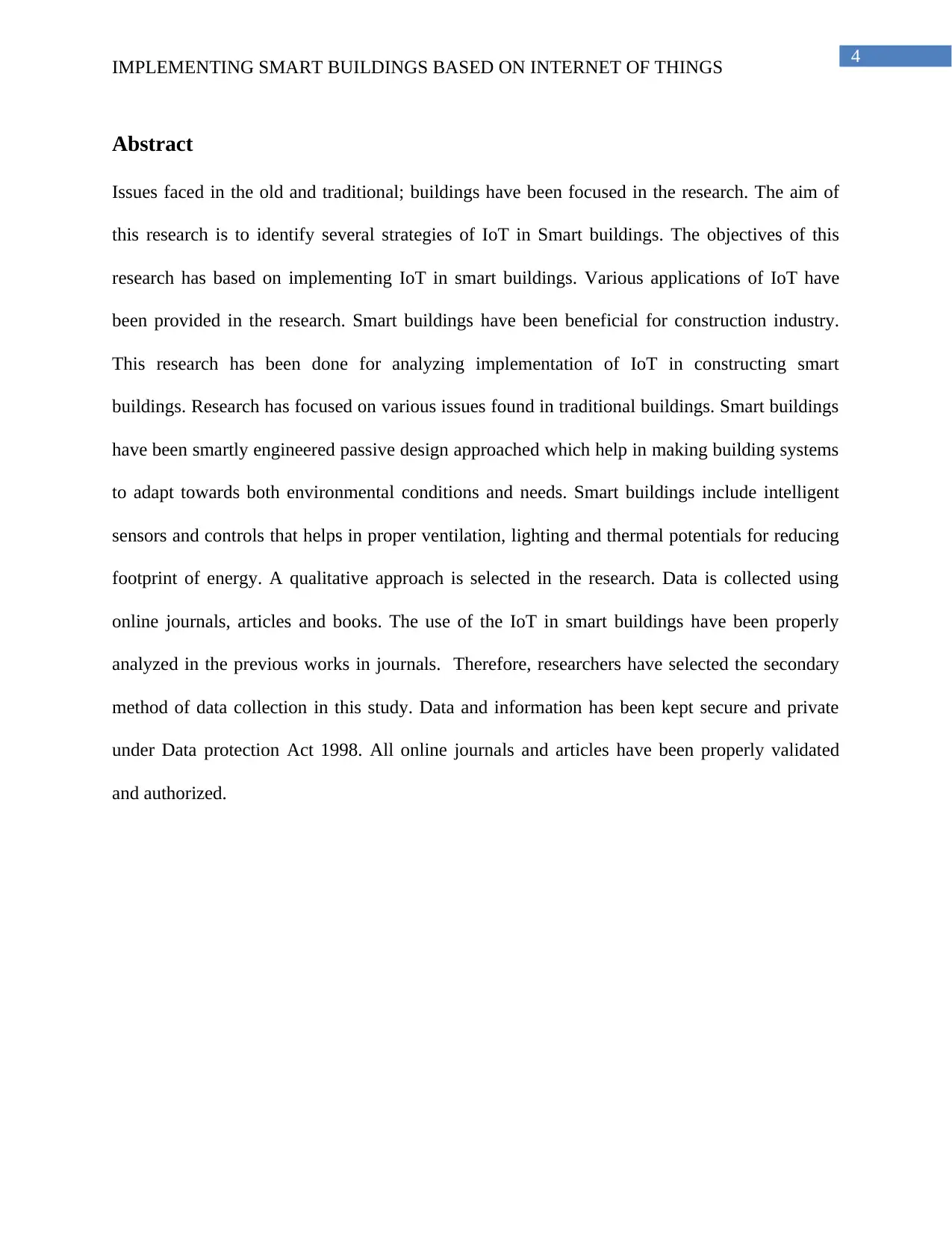
4
IMPLEMENTING SMART BUILDINGS BASED ON INTERNET OF THINGS
Abstract
Issues faced in the old and traditional; buildings have been focused in the research. The aim of
this research is to identify several strategies of IoT in Smart buildings. The objectives of this
research has based on implementing IoT in smart buildings. Various applications of IoT have
been provided in the research. Smart buildings have been beneficial for construction industry.
This research has been done for analyzing implementation of IoT in constructing smart
buildings. Research has focused on various issues found in traditional buildings. Smart buildings
have been smartly engineered passive design approached which help in making building systems
to adapt towards both environmental conditions and needs. Smart buildings include intelligent
sensors and controls that helps in proper ventilation, lighting and thermal potentials for reducing
footprint of energy. A qualitative approach is selected in the research. Data is collected using
online journals, articles and books. The use of the IoT in smart buildings have been properly
analyzed in the previous works in journals. Therefore, researchers have selected the secondary
method of data collection in this study. Data and information has been kept secure and private
under Data protection Act 1998. All online journals and articles have been properly validated
and authorized.
IMPLEMENTING SMART BUILDINGS BASED ON INTERNET OF THINGS
Abstract
Issues faced in the old and traditional; buildings have been focused in the research. The aim of
this research is to identify several strategies of IoT in Smart buildings. The objectives of this
research has based on implementing IoT in smart buildings. Various applications of IoT have
been provided in the research. Smart buildings have been beneficial for construction industry.
This research has been done for analyzing implementation of IoT in constructing smart
buildings. Research has focused on various issues found in traditional buildings. Smart buildings
have been smartly engineered passive design approached which help in making building systems
to adapt towards both environmental conditions and needs. Smart buildings include intelligent
sensors and controls that helps in proper ventilation, lighting and thermal potentials for reducing
footprint of energy. A qualitative approach is selected in the research. Data is collected using
online journals, articles and books. The use of the IoT in smart buildings have been properly
analyzed in the previous works in journals. Therefore, researchers have selected the secondary
method of data collection in this study. Data and information has been kept secure and private
under Data protection Act 1998. All online journals and articles have been properly validated
and authorized.
Paraphrase This Document
Need a fresh take? Get an instant paraphrase of this document with our AI Paraphraser

5
IMPLEMENTING SMART BUILDINGS BASED ON INTERNET OF THINGS
CHAPTER I: INTRODUCTION
Smart work and living environments have been becoming a new frontier for the
architectural, construction and engineering industry. Automation and control systems have been
installed in buildings that help managers in controlling heat, ventilation, air conditioning and
lightning systems (Ghayvat et al. 2015). Low voltage systems have been installed for
constructing reliable audio, video and security system. The main problem discussed in this
research has been related to traditional buildings. The shortage of land and space Automation in
building systems has been a modern approach to construction industry. The buildings are
constructed taller which causes environmental damage to soil and land. Traditional buildings
have been creating issues in space and lack of technology. There have been several accidents
reported related to damage of traditional buildings. Enhancing intelligence in built environment
require installing sensors and actuators in overall building for collecting relevant data and
information related to performance of building. IoT has helped in constructing smart buildings
in environment. IoT refers to concept of establishing local internet-accessible network of sensors
and devices for exchanging data. The advancement of IoT technologies have helped in seizing
modern business opportunities and mitigating traditional business challenges (Centenaro et al.
2016). It provides smart facilities and services in various fields including construction industry.
Various applications of IoT have been provided in the research. Smart buildings have been
beneficial for construction industry. This research has been done for analyzing implementation
of IoT in constructing smart buildings. Various factors that have been used in implementing IoT
in Smart buildings have been critically analysed in the research.
The primary aim of this research is to identify several strategies of IoT in Smart buildings. The
objectives of the research has been mentioned below:
IMPLEMENTING SMART BUILDINGS BASED ON INTERNET OF THINGS
CHAPTER I: INTRODUCTION
Smart work and living environments have been becoming a new frontier for the
architectural, construction and engineering industry. Automation and control systems have been
installed in buildings that help managers in controlling heat, ventilation, air conditioning and
lightning systems (Ghayvat et al. 2015). Low voltage systems have been installed for
constructing reliable audio, video and security system. The main problem discussed in this
research has been related to traditional buildings. The shortage of land and space Automation in
building systems has been a modern approach to construction industry. The buildings are
constructed taller which causes environmental damage to soil and land. Traditional buildings
have been creating issues in space and lack of technology. There have been several accidents
reported related to damage of traditional buildings. Enhancing intelligence in built environment
require installing sensors and actuators in overall building for collecting relevant data and
information related to performance of building. IoT has helped in constructing smart buildings
in environment. IoT refers to concept of establishing local internet-accessible network of sensors
and devices for exchanging data. The advancement of IoT technologies have helped in seizing
modern business opportunities and mitigating traditional business challenges (Centenaro et al.
2016). It provides smart facilities and services in various fields including construction industry.
Various applications of IoT have been provided in the research. Smart buildings have been
beneficial for construction industry. This research has been done for analyzing implementation
of IoT in constructing smart buildings. Various factors that have been used in implementing IoT
in Smart buildings have been critically analysed in the research.
The primary aim of this research is to identify several strategies of IoT in Smart buildings. The
objectives of the research has been mentioned below:
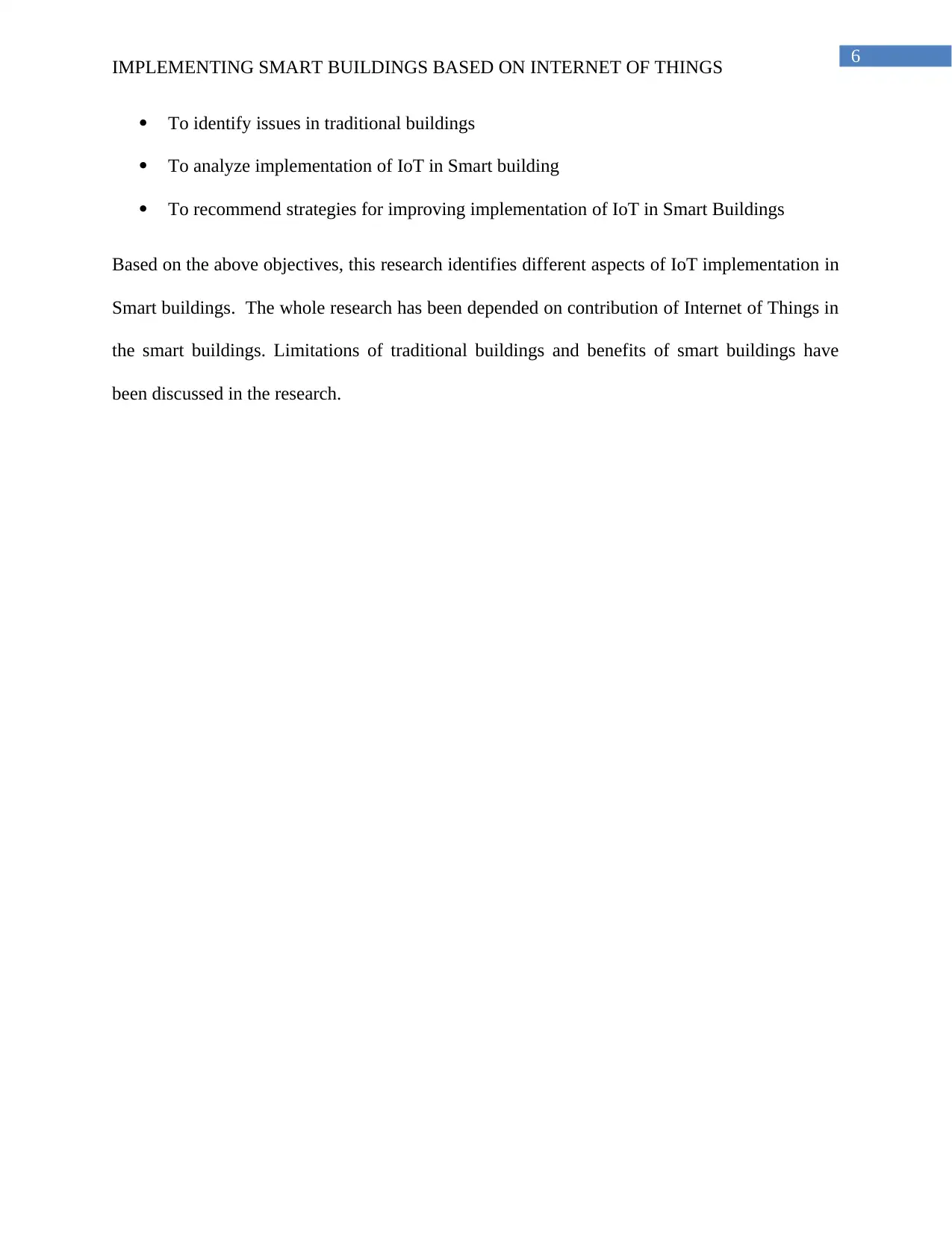
6
IMPLEMENTING SMART BUILDINGS BASED ON INTERNET OF THINGS
To identify issues in traditional buildings
To analyze implementation of IoT in Smart building
To recommend strategies for improving implementation of IoT in Smart Buildings
Based on the above objectives, this research identifies different aspects of IoT implementation in
Smart buildings. The whole research has been depended on contribution of Internet of Things in
the smart buildings. Limitations of traditional buildings and benefits of smart buildings have
been discussed in the research.
IMPLEMENTING SMART BUILDINGS BASED ON INTERNET OF THINGS
To identify issues in traditional buildings
To analyze implementation of IoT in Smart building
To recommend strategies for improving implementation of IoT in Smart Buildings
Based on the above objectives, this research identifies different aspects of IoT implementation in
Smart buildings. The whole research has been depended on contribution of Internet of Things in
the smart buildings. Limitations of traditional buildings and benefits of smart buildings have
been discussed in the research.
⊘ This is a preview!⊘
Do you want full access?
Subscribe today to unlock all pages.

Trusted by 1+ million students worldwide
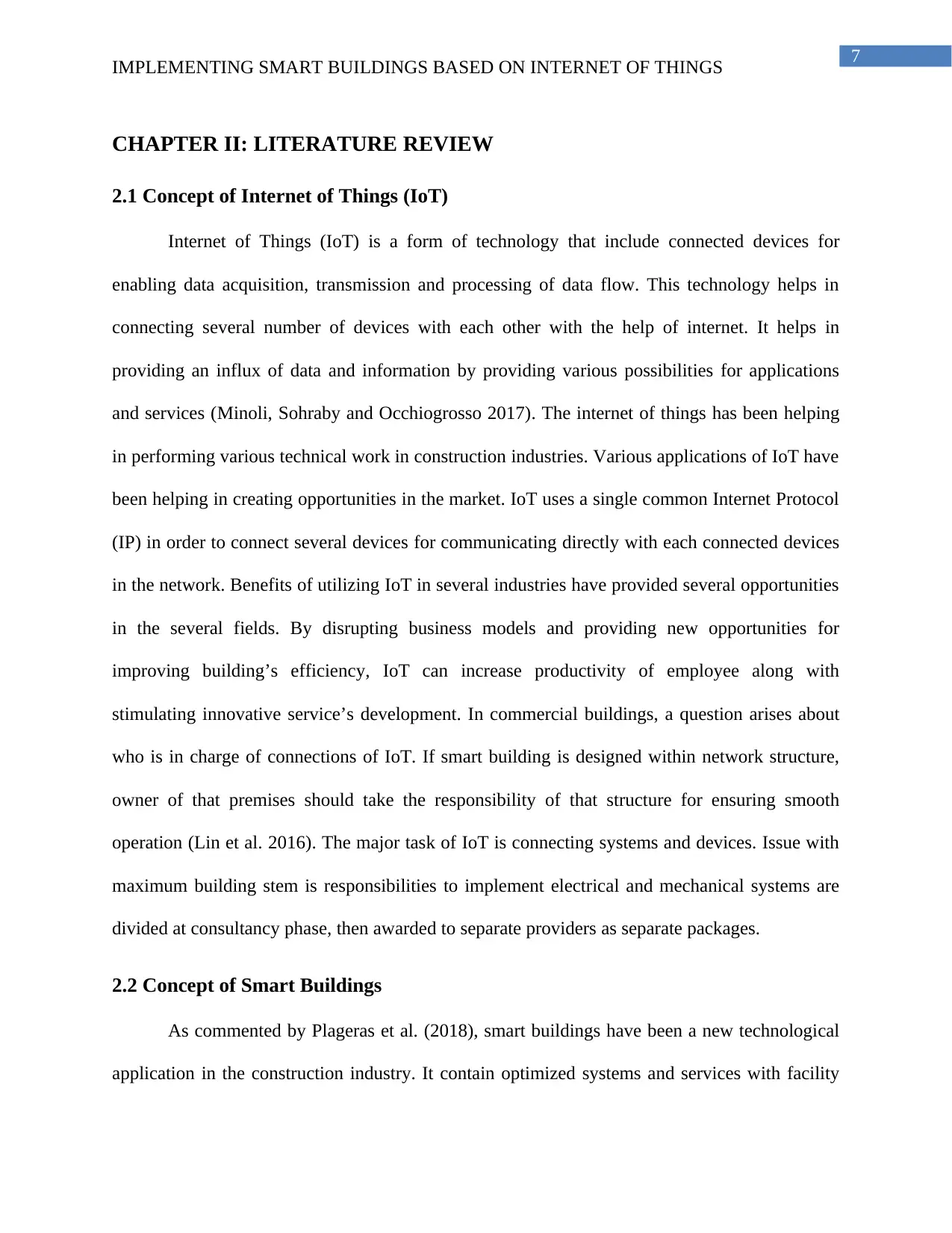
7
IMPLEMENTING SMART BUILDINGS BASED ON INTERNET OF THINGS
CHAPTER II: LITERATURE REVIEW
2.1 Concept of Internet of Things (IoT)
Internet of Things (IoT) is a form of technology that include connected devices for
enabling data acquisition, transmission and processing of data flow. This technology helps in
connecting several number of devices with each other with the help of internet. It helps in
providing an influx of data and information by providing various possibilities for applications
and services (Minoli, Sohraby and Occhiogrosso 2017). The internet of things has been helping
in performing various technical work in construction industries. Various applications of IoT have
been helping in creating opportunities in the market. IoT uses a single common Internet Protocol
(IP) in order to connect several devices for communicating directly with each connected devices
in the network. Benefits of utilizing IoT in several industries have provided several opportunities
in the several fields. By disrupting business models and providing new opportunities for
improving building’s efficiency, IoT can increase productivity of employee along with
stimulating innovative service’s development. In commercial buildings, a question arises about
who is in charge of connections of IoT. If smart building is designed within network structure,
owner of that premises should take the responsibility of that structure for ensuring smooth
operation (Lin et al. 2016). The major task of IoT is connecting systems and devices. Issue with
maximum building stem is responsibilities to implement electrical and mechanical systems are
divided at consultancy phase, then awarded to separate providers as separate packages.
2.2 Concept of Smart Buildings
As commented by Plageras et al. (2018), smart buildings have been a new technological
application in the construction industry. It contain optimized systems and services with facility
IMPLEMENTING SMART BUILDINGS BASED ON INTERNET OF THINGS
CHAPTER II: LITERATURE REVIEW
2.1 Concept of Internet of Things (IoT)
Internet of Things (IoT) is a form of technology that include connected devices for
enabling data acquisition, transmission and processing of data flow. This technology helps in
connecting several number of devices with each other with the help of internet. It helps in
providing an influx of data and information by providing various possibilities for applications
and services (Minoli, Sohraby and Occhiogrosso 2017). The internet of things has been helping
in performing various technical work in construction industries. Various applications of IoT have
been helping in creating opportunities in the market. IoT uses a single common Internet Protocol
(IP) in order to connect several devices for communicating directly with each connected devices
in the network. Benefits of utilizing IoT in several industries have provided several opportunities
in the several fields. By disrupting business models and providing new opportunities for
improving building’s efficiency, IoT can increase productivity of employee along with
stimulating innovative service’s development. In commercial buildings, a question arises about
who is in charge of connections of IoT. If smart building is designed within network structure,
owner of that premises should take the responsibility of that structure for ensuring smooth
operation (Lin et al. 2016). The major task of IoT is connecting systems and devices. Issue with
maximum building stem is responsibilities to implement electrical and mechanical systems are
divided at consultancy phase, then awarded to separate providers as separate packages.
2.2 Concept of Smart Buildings
As commented by Plageras et al. (2018), smart buildings have been a new technological
application in the construction industry. It contain optimized systems and services with facility
Paraphrase This Document
Need a fresh take? Get an instant paraphrase of this document with our AI Paraphraser
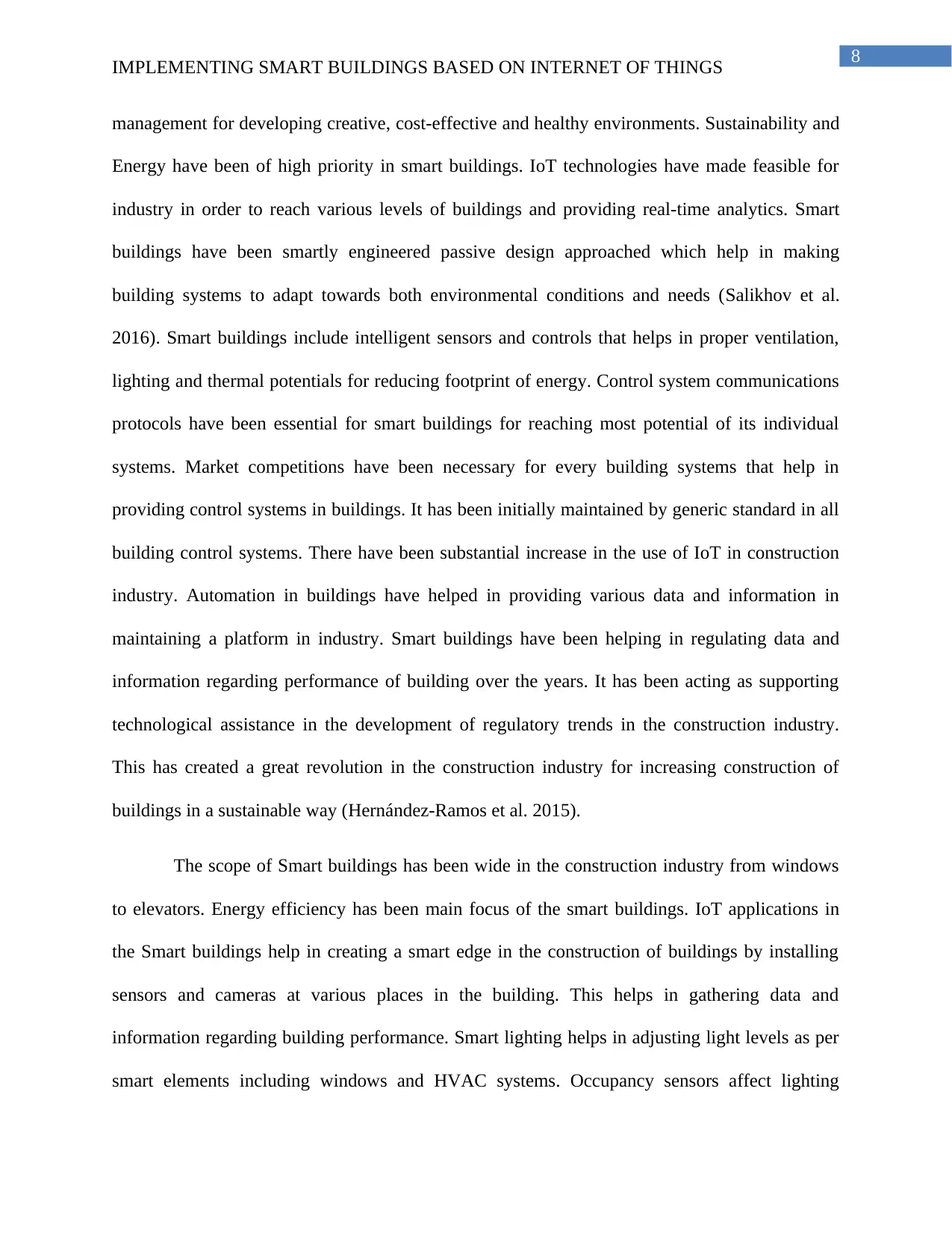
8
IMPLEMENTING SMART BUILDINGS BASED ON INTERNET OF THINGS
management for developing creative, cost-effective and healthy environments. Sustainability and
Energy have been of high priority in smart buildings. IoT technologies have made feasible for
industry in order to reach various levels of buildings and providing real-time analytics. Smart
buildings have been smartly engineered passive design approached which help in making
building systems to adapt towards both environmental conditions and needs (Salikhov et al.
2016). Smart buildings include intelligent sensors and controls that helps in proper ventilation,
lighting and thermal potentials for reducing footprint of energy. Control system communications
protocols have been essential for smart buildings for reaching most potential of its individual
systems. Market competitions have been necessary for every building systems that help in
providing control systems in buildings. It has been initially maintained by generic standard in all
building control systems. There have been substantial increase in the use of IoT in construction
industry. Automation in buildings have helped in providing various data and information in
maintaining a platform in industry. Smart buildings have been helping in regulating data and
information regarding performance of building over the years. It has been acting as supporting
technological assistance in the development of regulatory trends in the construction industry.
This has created a great revolution in the construction industry for increasing construction of
buildings in a sustainable way (Hernández-Ramos et al. 2015).
The scope of Smart buildings has been wide in the construction industry from windows
to elevators. Energy efficiency has been main focus of the smart buildings. IoT applications in
the Smart buildings help in creating a smart edge in the construction of buildings by installing
sensors and cameras at various places in the building. This helps in gathering data and
information regarding building performance. Smart lighting helps in adjusting light levels as per
smart elements including windows and HVAC systems. Occupancy sensors affect lighting
IMPLEMENTING SMART BUILDINGS BASED ON INTERNET OF THINGS
management for developing creative, cost-effective and healthy environments. Sustainability and
Energy have been of high priority in smart buildings. IoT technologies have made feasible for
industry in order to reach various levels of buildings and providing real-time analytics. Smart
buildings have been smartly engineered passive design approached which help in making
building systems to adapt towards both environmental conditions and needs (Salikhov et al.
2016). Smart buildings include intelligent sensors and controls that helps in proper ventilation,
lighting and thermal potentials for reducing footprint of energy. Control system communications
protocols have been essential for smart buildings for reaching most potential of its individual
systems. Market competitions have been necessary for every building systems that help in
providing control systems in buildings. It has been initially maintained by generic standard in all
building control systems. There have been substantial increase in the use of IoT in construction
industry. Automation in buildings have helped in providing various data and information in
maintaining a platform in industry. Smart buildings have been helping in regulating data and
information regarding performance of building over the years. It has been acting as supporting
technological assistance in the development of regulatory trends in the construction industry.
This has created a great revolution in the construction industry for increasing construction of
buildings in a sustainable way (Hernández-Ramos et al. 2015).
The scope of Smart buildings has been wide in the construction industry from windows
to elevators. Energy efficiency has been main focus of the smart buildings. IoT applications in
the Smart buildings help in creating a smart edge in the construction of buildings by installing
sensors and cameras at various places in the building. This helps in gathering data and
information regarding building performance. Smart lighting helps in adjusting light levels as per
smart elements including windows and HVAC systems. Occupancy sensors affect lighting
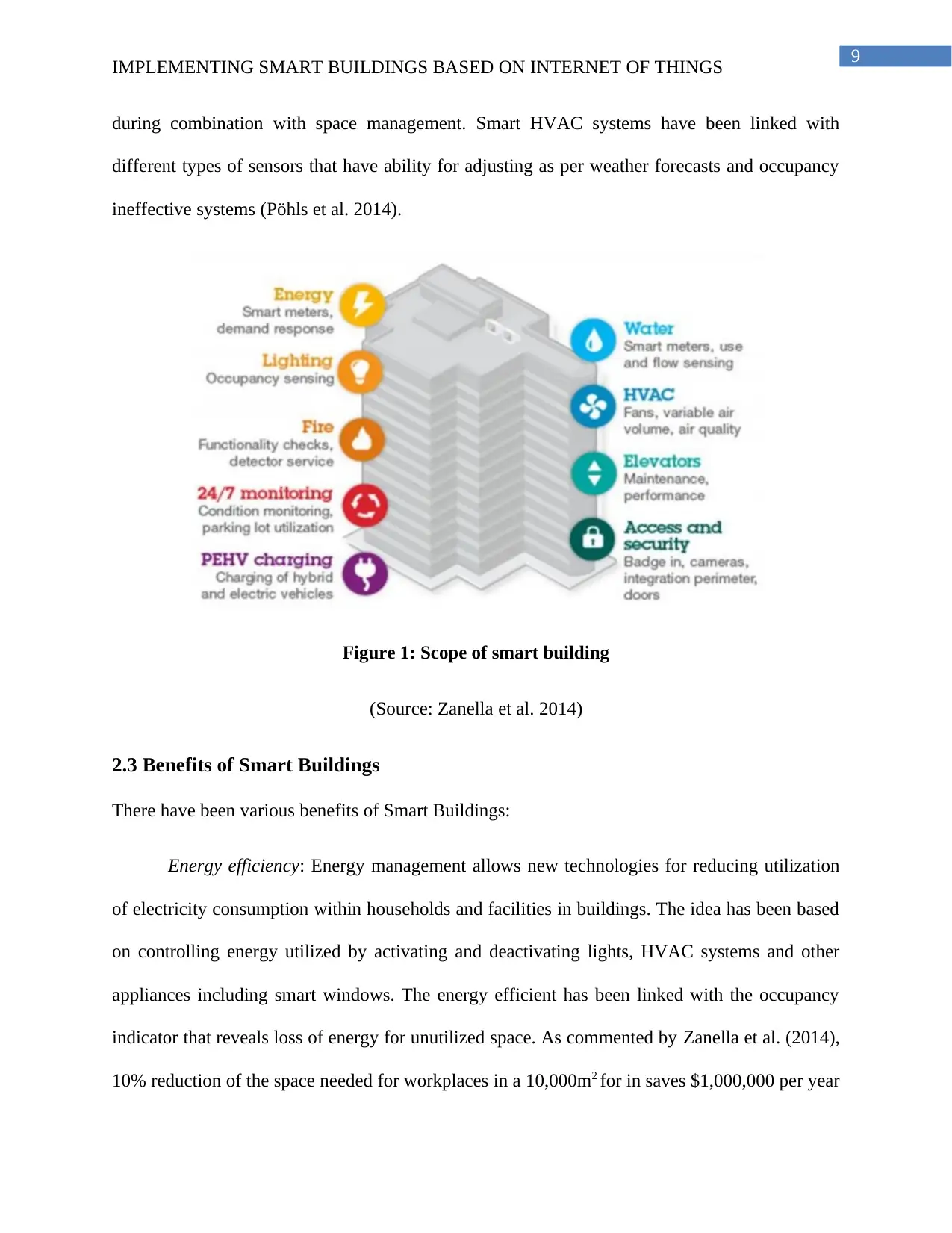
9
IMPLEMENTING SMART BUILDINGS BASED ON INTERNET OF THINGS
during combination with space management. Smart HVAC systems have been linked with
different types of sensors that have ability for adjusting as per weather forecasts and occupancy
ineffective systems (Pöhls et al. 2014).
Figure 1: Scope of smart building
(Source: Zanella et al. 2014)
2.3 Benefits of Smart Buildings
There have been various benefits of Smart Buildings:
Energy efficiency: Energy management allows new technologies for reducing utilization
of electricity consumption within households and facilities in buildings. The idea has been based
on controlling energy utilized by activating and deactivating lights, HVAC systems and other
appliances including smart windows. The energy efficient has been linked with the occupancy
indicator that reveals loss of energy for unutilized space. As commented by Zanella et al. (2014),
10% reduction of the space needed for workplaces in a 10,000m2 for in saves $1,000,000 per year
IMPLEMENTING SMART BUILDINGS BASED ON INTERNET OF THINGS
during combination with space management. Smart HVAC systems have been linked with
different types of sensors that have ability for adjusting as per weather forecasts and occupancy
ineffective systems (Pöhls et al. 2014).
Figure 1: Scope of smart building
(Source: Zanella et al. 2014)
2.3 Benefits of Smart Buildings
There have been various benefits of Smart Buildings:
Energy efficiency: Energy management allows new technologies for reducing utilization
of electricity consumption within households and facilities in buildings. The idea has been based
on controlling energy utilized by activating and deactivating lights, HVAC systems and other
appliances including smart windows. The energy efficient has been linked with the occupancy
indicator that reveals loss of energy for unutilized space. As commented by Zanella et al. (2014),
10% reduction of the space needed for workplaces in a 10,000m2 for in saves $1,000,000 per year
⊘ This is a preview!⊘
Do you want full access?
Subscribe today to unlock all pages.

Trusted by 1+ million students worldwide
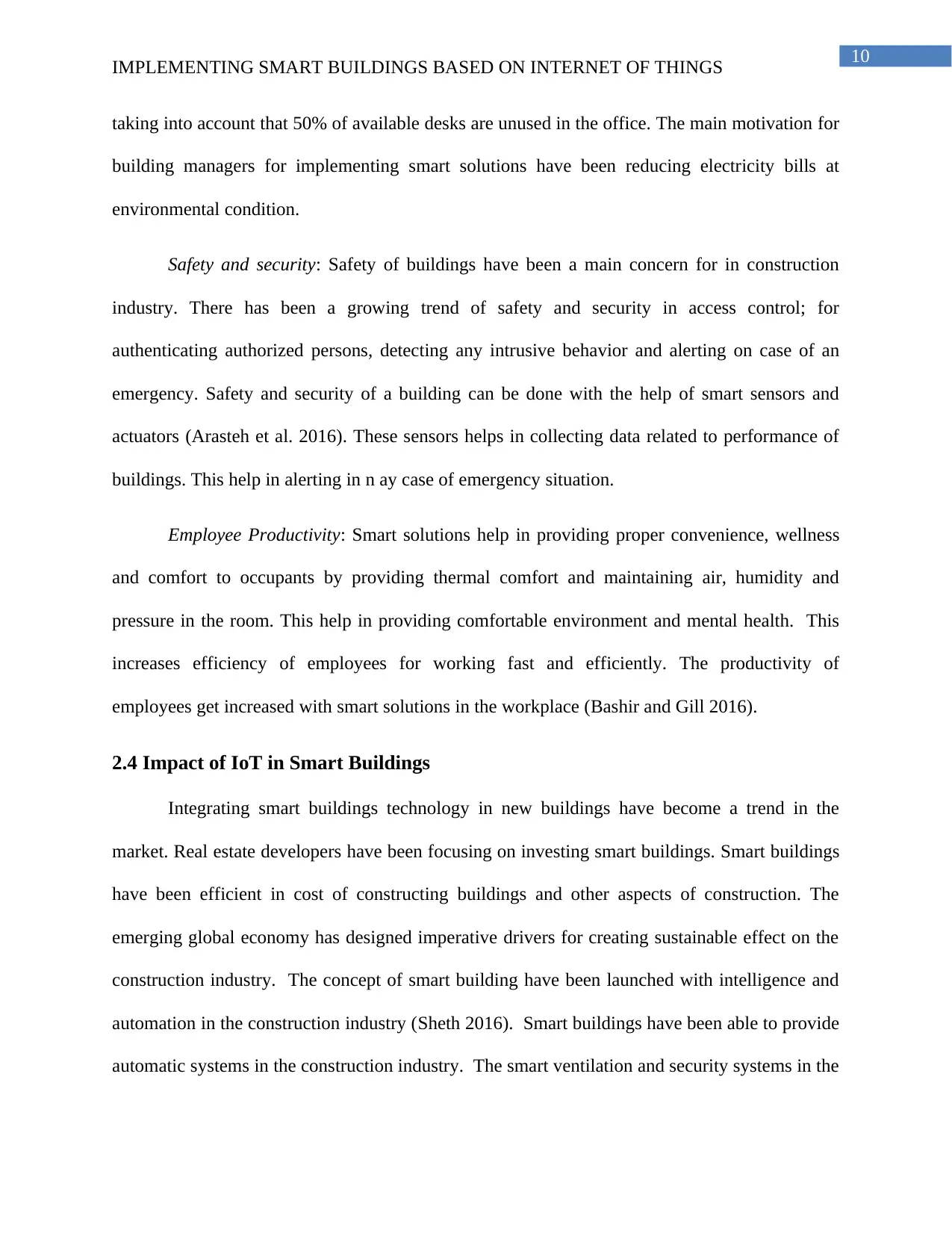
10
IMPLEMENTING SMART BUILDINGS BASED ON INTERNET OF THINGS
taking into account that 50% of available desks are unused in the office. The main motivation for
building managers for implementing smart solutions have been reducing electricity bills at
environmental condition.
Safety and security: Safety of buildings have been a main concern for in construction
industry. There has been a growing trend of safety and security in access control; for
authenticating authorized persons, detecting any intrusive behavior and alerting on case of an
emergency. Safety and security of a building can be done with the help of smart sensors and
actuators (Arasteh et al. 2016). These sensors helps in collecting data related to performance of
buildings. This help in alerting in n ay case of emergency situation.
Employee Productivity: Smart solutions help in providing proper convenience, wellness
and comfort to occupants by providing thermal comfort and maintaining air, humidity and
pressure in the room. This help in providing comfortable environment and mental health. This
increases efficiency of employees for working fast and efficiently. The productivity of
employees get increased with smart solutions in the workplace (Bashir and Gill 2016).
2.4 Impact of IoT in Smart Buildings
Integrating smart buildings technology in new buildings have become a trend in the
market. Real estate developers have been focusing on investing smart buildings. Smart buildings
have been efficient in cost of constructing buildings and other aspects of construction. The
emerging global economy has designed imperative drivers for creating sustainable effect on the
construction industry. The concept of smart building have been launched with intelligence and
automation in the construction industry (Sheth 2016). Smart buildings have been able to provide
automatic systems in the construction industry. The smart ventilation and security systems in the
IMPLEMENTING SMART BUILDINGS BASED ON INTERNET OF THINGS
taking into account that 50% of available desks are unused in the office. The main motivation for
building managers for implementing smart solutions have been reducing electricity bills at
environmental condition.
Safety and security: Safety of buildings have been a main concern for in construction
industry. There has been a growing trend of safety and security in access control; for
authenticating authorized persons, detecting any intrusive behavior and alerting on case of an
emergency. Safety and security of a building can be done with the help of smart sensors and
actuators (Arasteh et al. 2016). These sensors helps in collecting data related to performance of
buildings. This help in alerting in n ay case of emergency situation.
Employee Productivity: Smart solutions help in providing proper convenience, wellness
and comfort to occupants by providing thermal comfort and maintaining air, humidity and
pressure in the room. This help in providing comfortable environment and mental health. This
increases efficiency of employees for working fast and efficiently. The productivity of
employees get increased with smart solutions in the workplace (Bashir and Gill 2016).
2.4 Impact of IoT in Smart Buildings
Integrating smart buildings technology in new buildings have become a trend in the
market. Real estate developers have been focusing on investing smart buildings. Smart buildings
have been efficient in cost of constructing buildings and other aspects of construction. The
emerging global economy has designed imperative drivers for creating sustainable effect on the
construction industry. The concept of smart building have been launched with intelligence and
automation in the construction industry (Sheth 2016). Smart buildings have been able to provide
automatic systems in the construction industry. The smart ventilation and security systems in the
Paraphrase This Document
Need a fresh take? Get an instant paraphrase of this document with our AI Paraphraser

11
IMPLEMENTING SMART BUILDINGS BASED ON INTERNET OF THINGS
smart buildings have been playing an important role in the development of comfort zone in
occupant’s life.
Figure 2: Evolution of smart buildings
(Source: Shih et al. 2016)
The basic requirement of smart building has been energy efficient and providing a
healthy living environment for occupants. It provides additional features including automation,
flexibility, and renewable energy production and user friendly controls. Smart buildings can be
constructed with the help of components, outcomes and functions (Zafari, Papapanagiotou and
Christidis 2015). The effectiveness of smart buildings have been providing flexibility in systems.
IoT in buildings is an emerging and revolutionary technology having the potential to redefine the
way people are living. As per the research done by Mohammadi et al. (2017), half of world’s
population live in cities and towns and it is expected that by the year 2050 almost 66% will be
IMPLEMENTING SMART BUILDINGS BASED ON INTERNET OF THINGS
smart buildings have been playing an important role in the development of comfort zone in
occupant’s life.
Figure 2: Evolution of smart buildings
(Source: Shih et al. 2016)
The basic requirement of smart building has been energy efficient and providing a
healthy living environment for occupants. It provides additional features including automation,
flexibility, and renewable energy production and user friendly controls. Smart buildings can be
constructed with the help of components, outcomes and functions (Zafari, Papapanagiotou and
Christidis 2015). The effectiveness of smart buildings have been providing flexibility in systems.
IoT in buildings is an emerging and revolutionary technology having the potential to redefine the
way people are living. As per the research done by Mohammadi et al. (2017), half of world’s
population live in cities and towns and it is expected that by the year 2050 almost 66% will be

12
IMPLEMENTING SMART BUILDINGS BASED ON INTERNET OF THINGS
dwelling in urban regions. In days to come there will be significant changes in the ways
buildings are developed (Cheng et al. 2015). The existing definition of smart buildings refers
mainly to building automation system which is also termed as Building Management System. It
is responsible for controlling and monitoring building’s mechanical equipment and electrical
equipment. These equipment include power systems, ventilation, security systems, fire systems
and lighting. Smart buildings make use of information technology to establish connections in
between various subsystems enabling these to share information among them. The sharing of
information in between these subsystems helps in optimizing the overall building performance.
Smart buildings can interact with the IT systems of the utility providers and the dedicated
software supporting facility management (Mohanty, Choppali and Kougianos 2016). Smart
buildings can be considered to be enhanced versions of intelligent buildings. IoT makes use of a
common Internet Protocol to establish connection between various devices. It provides the
devices with the facility to communicate with one another as well as with cloud services. IoT in
buildings is termed as Building Internet of Things or BIoT and is defined as the overlaying of
Internet Protocol network establishing connection between all the services (Barcelo et al. 2016).
The technology helps in analyzing, controlling as well as monitoring all the building services.
IoT provides internet connection as well as remote management of various mobile appliances. It
facilitates use of sensors in home appliances that include air-conditioning, geysers, lights and
other such devices (Lea and Blackstock 2014). It is effective in embedding computer intelligence
to the home appliances thereby helping in monitoring the functionality of these appliances.
Cloud computing is a vital part of Internet of Things providing scalable computing power along
with storage space for maintaining and running various home services. Smart home systems
comprise of sensors as well as switches that are connected to central hub. The centralized hub is
IMPLEMENTING SMART BUILDINGS BASED ON INTERNET OF THINGS
dwelling in urban regions. In days to come there will be significant changes in the ways
buildings are developed (Cheng et al. 2015). The existing definition of smart buildings refers
mainly to building automation system which is also termed as Building Management System. It
is responsible for controlling and monitoring building’s mechanical equipment and electrical
equipment. These equipment include power systems, ventilation, security systems, fire systems
and lighting. Smart buildings make use of information technology to establish connections in
between various subsystems enabling these to share information among them. The sharing of
information in between these subsystems helps in optimizing the overall building performance.
Smart buildings can interact with the IT systems of the utility providers and the dedicated
software supporting facility management (Mohanty, Choppali and Kougianos 2016). Smart
buildings can be considered to be enhanced versions of intelligent buildings. IoT makes use of a
common Internet Protocol to establish connection between various devices. It provides the
devices with the facility to communicate with one another as well as with cloud services. IoT in
buildings is termed as Building Internet of Things or BIoT and is defined as the overlaying of
Internet Protocol network establishing connection between all the services (Barcelo et al. 2016).
The technology helps in analyzing, controlling as well as monitoring all the building services.
IoT provides internet connection as well as remote management of various mobile appliances. It
facilitates use of sensors in home appliances that include air-conditioning, geysers, lights and
other such devices (Lea and Blackstock 2014). It is effective in embedding computer intelligence
to the home appliances thereby helping in monitoring the functionality of these appliances.
Cloud computing is a vital part of Internet of Things providing scalable computing power along
with storage space for maintaining and running various home services. Smart home systems
comprise of sensors as well as switches that are connected to central hub. The centralized hub is
⊘ This is a preview!⊘
Do you want full access?
Subscribe today to unlock all pages.

Trusted by 1+ million students worldwide
1 out of 29
Related Documents
Your All-in-One AI-Powered Toolkit for Academic Success.
+13062052269
info@desklib.com
Available 24*7 on WhatsApp / Email
![[object Object]](/_next/static/media/star-bottom.7253800d.svg)
Unlock your academic potential
Copyright © 2020–2025 A2Z Services. All Rights Reserved. Developed and managed by ZUCOL.





